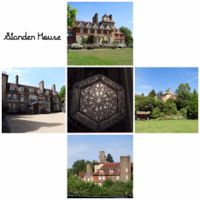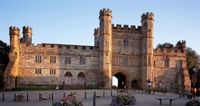
Ducklings at Sheffield Park.
Photo © Jayne Gutteridge
In celebration (or commiseration?) of my impending septuagenarianisation, Jayne took me on holiday to the destination of my choice. She was a little taken aback that, rather than Prague or some such exotic continental destination, I chose Sussex, where I lived from the age of 11 until I moved to Norfolk in my early 20s.
Jayne found an ex gamekeeper’s lodge for us to stay in near Sheffield Park, so the park was our first port of call. The estate consists of fields and woodlands surrounding the park itself, which is laid out with lakes and walks, planted with specimen trees, on a grand scale. It was created by the third Earl of Sheffield, an eccentric Victorian bachelor obsessed with cricket, to provide an impressive walk for his guests from his house (a Georgian Gothic pile, privately owned and not open to the public) to his cricket ground.

Ducklings at Sheffield Park.
Photo © Jayne Gutteridge
The Earl, described as “benevolent and kind but also quick tempered”, managed to squander his vast fortune on trees, travel and cricket, and vast acts of random charity. At the age of 63 he “adopted” the 24-year-old daughter of the local vicar. On one occasion they gave an outdoor feast to 2,000 local children, seated at tables that stretched for a mile.
It was an extremely hot and sunny day, so the trees and lakes made for a pleasant walking environment. Water lilies, white, yellow, pink and red, were in bloom, dragonflies darted over the waters, and ducklings dabbled endearingly among the lily pads. We had a quick look at the cricket ground, where W G Grace frequently played. It looked like any other area of grass mown to within a millimetre of its life.

On the Bluebell Railway
Photo © Jayne Gutteridge
After a light lunch, we struck off across the fields to the nearby Bluebell Railway. The Bluebell became the first preserved railway in 1960 and I remember visiting it soon after. It now has around 30 steam engines and masses of rolling stock, and famous steam engines regularly visit it. We took a 3rd class return from Sheffield Park to East Grinstead through rolling countryside – a most enjoyable journey. Over the following weekend, after closing time, several different engines could be heard from our cottage, whistling until dusk. One could imagine all the volunteer staff playing with their life-sized train set!
At both these venues I was amused to see the same man, with dyed chestnut colour hair and full, fluffy white beard, accompanying an elderly lady. He spoke in a high fluting voice and observed the world down his aquiline nose, whilst adopting the poses and gestures of an 18th century Beau. I mentally christened him Monsieur le Poseur.

Standen House.
Photo © Jayne Gutteridge
The next day we visited Standen House – a most peculiar house built in 1890 but looking as if it was built in the 1930s, with a massive tower of chimneys with windows in it, and a little cottage perched on the very top of the roof. This is an Arts & Crafts house, built for James and Margaret Beale. Beale was a non-conformist from Birmingham - a solicitor specialising in dealings with the railways. William Morris was involved in the design of the house.
Margaret insisted on all her daughters embroidering cushions. She designed the gardens, which are beautiful. However, we both found the decoration and the ornaments of the house overwhelmingly busy and decidedly un-restful. Some of the pieces on their own would have been very attractive, but en masse they were just too much. In photographs, the family looked thoroughly miserable.
As the heat and humidity was continuing, we decided to go to the top of Firle Beacon on the Downs in search of a breeze. Time was that I used to enjoy climbing the Downs, but these days I’d rather drive to the top, as you can at Firle – an exciting hill climb up the escarpment. After admiring the view of the Weald, we turned and walked a little way down towards the sea and back.
Bob Copper tells the story, in his autobiography “A Song for Every Season”, of how when he was a small boy his father woke him in the very early hours of Midsummer’s Day and walked him from their home in Rottingdean, over the Downs to Kingston Head above Lewes to watch the sun rise in the gap between Mount Caburn and Firle Beacon.
Next stop was the picture postcard village of Alfriston where we had a very nice cream tea, and were disappointed to find the Priest’s house closed on Thursdays and Fridays, and so we continued to Highandover, as I reminisced about an early driving lesson where, at the start of the serpentine ascent, the instructor said, “let’s get this car moving, sir!” and pressed his foot down hard on his dual control accelerator. At the top, we stopped to see the spectacular view of the Cuckmere valley with its meanders and oxbows, and then we drove down to Cuckmere Haven and up the other side of the valley home.
The following day we set out for Battle Abbey, calling at Batemans, the home of Rudyard Kipling, on the way. As a member of Eastbourne Shakespeare Society, I used to act in the grounds of Batemans, so when we arrived just behind a coachload of Germans, we flashed our National Trust membership cards and, using my local knowledge, scuttled past them, heading for the far end of the gardens where I knew there was a wild flower meadow leading to the water mill which Kipling immortalised in verse:
See you our little mill,
So busy by the brook?
She has ground her corn and paid her tax
Ever since Domesday Book.
We returned to the house just as it was opened to the public. It’s a very poignant place. 97% of the contents are as they were in Kipling’s time. It was a lovely home, but the loss of his daughter Josephine to pneumonia at the age of 7, and of his son John, missing presumed dead in the Great War, left him a sad and broken man. In a shed in the garden is his Rolls Royce, which was apparently a disappointingly unreliable vehicle.

Battle Abbey gatehouse
Battle Abbey has a stupendously impressive gatehouse. Inside, a private school, which was having a parents’ day, occupies the Abbot’s palace, so the town was full of children in uniform, parents, and gowned masters. There are the remains of the rest of the abbey, and, of course, the battlefield where William the Conqueror conquered.
I’m sure you don’t need me to tell you that the battle of Hastings didn’t happen at Hastings – in fact William the Bastard, as he was known before the battle, never went near Hastings. I don’t blame him; it’s not that impressive. He landed at Norman’s Bay, which no doubt seemed the logical thing to do, as he was a Norman. Equally logically, Harold waited for him at Battle, as he was expecting a battle.
When you look at the battlefield, and read the account of the battle, it is very clear that William could very easily have lost. Harold had just fought off a load of mad Norwegians at Stamford Bridge. Norwegian tactics consisted of rushing at your foe, dressed only in your shirt, and swinging an axe. The Normans, however, were far more devious, pretending to run away and then encircling such of their enemies who fell for it and followed them. Harold saw through their cheating ways, but couldn’t restrain his men from falling into the trap.
It is said that after the battle, Harold’s widow, Edith Swanneck, begged permission to gather up her husband’s dismembered remains for decent burial. When the Abbot’s palace was the home of Sir Augustus Webster during the 19th century, there was a story that the ghost of Edith could be seen, dressed in a long, flowing, white gown, wandering the grounds with Harold’s head under her arm, looking for the rest of him. It later transpired that Sir Augustus had an elderly female relative living with him who suffered from dementia, and who would often roam the garden at night in her nightdress, carrying her chamber pot under her arm.
After that, we went to Pevensey castle – a Norman keep inside a Roman bailey. Some of the towers of the keep contained hidden rooms built for the Home Guard during and after the war. It is fairly certain that my first wife’s father would have used these rooms as he was a captain in the Home Guard after the war, and was the assistant manager of Pevensey Bay branch of the Midland Bank. His name was neither Mannering nor Wilson.
It would be foolish to stay so close to Lewes without visiting the shop attached to Harvey’s Brewery. Having stocked up on some very fine ales, we went to look at the priory. William the Conqueror’s friend William de Warren was in charge of Lewes castle, and funded the building of a Cluniac priory in Lewes, as a sister house to the Cluniac priory in his home town in France. I lived in Lewes for a couple of years half a century ago, and coincidentally now live in Castle Acre, where William de Warren also built a castle and a Cluniac priory.
Having looked at the priory ruins – nowhere near as impressive as those in Castle Acre – we moved on to Anne of Cleves’ house. This is a classic Wealden farmhouse, given to Anne by Henry VIII as part of her divorce settlement. I doubt if she ever went there – it was probably just a source of income. However, it’s a beautiful house, containing some lovely furniture, an exhibition of Sussex ironwork, and the town museum. It has very pleasant gardens and it also serves excellent cream teas.
Thus fortified, we headed down the Ouse valley, stopping at Rodmell to have a look at Monks House – Virginia Wolfe’s country retreat. T S Elliot described it as the most uncomfortable house he’d ever stayed in, and I can see what he meant. Like Batemans, Monks House is furnished and decorated almost exactly as it was in its owner’s day. The house is cold and damp, and used to be frequently flooded by the nearby river. The furniture, paintings, fireplace surrounds etc. were all made or painted by Virginia’s sister or friends and relations. Both of us came to the separate conclusion that they looked to have been done by a not very creative toddler.
All in all, it comes as no great surprise that Virginia decided to drown herself in the aforementioned nearby river.
Skirting round the back of Newhaven, we set off along the coast road towards Eastbourne, but were lured north by a brown sign for a motor museum. We passed through Jevington and eventually arrived in Wannock, where we saw a sign pointing back the way we had come. Jayne checked for the museum on the internet and found that viewing was by appointment only.
Whilst in the area we had a quick look at the Long Man of Willmington, who was much as I remembered him. There was a time when I could run up the escarpment beside him without pausing. On this occasion we decided to view him from the car park. It was very hot.
I decided to go to Norman’s Bay, which used to be my favourite swimming beach in my youth. I nearly got the car stuck in the shingle, but the sea was a flat calm and lovely and cool. Jayne stayed in the car while I swam, I soon dried off in the sun, and then we drove to Bexhill on an unsuccessful hunt for fish and chips. We eventually found a fish and chip shop next to the newsagents for whom I was once a fairly useless newspaper boy in Hailsham.
Visiting a National Trust garden on a Monday outside the school holidays, we didn’t expect it to be very busy, but the car park at Nymans was nearly full not long after it had opened. This garden and Kew’s country home at Wakehurst, which we visited next, were favourite haunts of my parents when they retired to Sussex. Both places are lovely, and Wakehurst is vast in size and has trees and shrubs from all over the world. We particularly enjoyed the water gardens and the Himalayan glade. Leaving the car park at Nymans, we were followed by a large camper van. Misled by the road markings in the car park, I went the wrong way, with the camper van following. At the end of a row of cars was a gap between the last car and a tree with just enough space for our car to get through. I’m afraid we left the car park without looking in the mirror to see how the camper van extricated itself from the mess I’d got it into On the way home we looked in at West Hoathly to see the Priest’s house, but it was closed on Mondays. We don’t seem to have much luck with Priest’s houses!
For our final full day, the weather broke so, in an intermittent drizzle, we set off to Crowborough where the Saxophone Shop has its headquarters to look at some baritone saxes. After trying four different ones, Jayne fell in love with one particular instrument so we brought it away with us. Much hilarity was caused by my selection of a pair of earplugs to go with the instrument.
After lunch at our cottage we went to have a look at Bentley Wildfowl Trust and Motor Museum. The museum had some splendid old cars, and the rain held off while we went round the wildfowl. On a previous visit some years ago, it was rather a bleak place, but has now matured with trees, streams and ponds. Many of the birds roam free within the fox-proof fence, and there are fowl from all over the world.
Just inside the entrance gate, we encountered two members of staff running towards us. One of them called out, “we’ve just seen a mink”, and they vaulted over fences in pursuit. The mink doubled back and shot along the opposite bank of the pond from us, so we called the men to let them know. They came back, one with a shotgun, and managed to corner and shoot it. They told us that a mink got in once before and they lost 70 birds in one night.
There were many beautiful ducks, geese and swans, also cranes, storks and flamingos. A whooper swan took exception to Jayne and made a fair attempt at attacking here over the fence, but the rest of the birds seemed friendly enough.
We finished off the day with a pub meal at the Fox and Hounds, Haywards Heath, which had changed out of all recognition since the days when I used to host the folk club there.
Text © Chris Gutteridge 2017